Software has pushed the optics and photonics fields forward in myriad ways, sometimes with
profound effects on business and culture. Would we have been able to take full advantage
of the many technology advances in the past five decades – including the laser
– if it weren’t for optical design software?
Optical design software often is indispensable to daily life for those working with optical
systems in lasers, imaging, nonimaging optics or visual systems. From lithography
to telescopes, scanners to interferometers, the list of optical tools that could
not operate – or at least could not operate as effectively – without
optical design software is extensive.

This is an optical system layout
created by the OSLO (Optics Software for Layout and Optimization) design program
of a high stray light-rejection telescope with on- and off-axis ray bundles traced.
Courtesy of Lambda Research Corp.
When optical software was first introduced, it was specifically
written for hand calculators to trace a few rays to design doublets and triplets.
Traditionally, these types of programs performed ray-based modeling of optical systems
such as lenses and telescopes, and the applications and requirements were straightforward
by today’s standards.
Over time, software has become more and more sophisticated, changing
as the needs of the optical designer changes. For example, today’s optical
designers are creating new types of systems such as advanced light pipes, LCD projector
systems, microprojectors that exhibit uniformity, and systems that require brightness
and spectral specifications well beyond those requested in the past.
Imaging and illumination
Historically, the biggest market for optical design software has
been in imaging applications. Imaging is still a very important market segment,
as increasingly more complicated designs and optical elements are being employed;
e.g., complex lens shapes such as polynomial and free-form lenses are being used
within nonrotationally symmetric geometries, even to manipulating complex light
properties such as polarization.

OSLO generates a wavefront map of a segmented mirror showing the peak-to-valley optical path distance (OPD). Courtesy of Lambda Research Corp.
What’s more, imaging applications are increasingly affected
by cost, size and packaging constraints, which makes the use of optimization and
tolerancing capabilities in optical design software critical to the manufacturability
and competitiveness of the application.
CODE V, a software system used in the development of the compact
disc, was developed by Optical Research Associates (ORA, now known as the Optical
Solutions Group), part of Synopsys Inc. of Mountain View, Calif. The software’s
algorithms now are a key and dominant technology in the design of the microlithographic
lenses used by many chip makers in their attempts to keep pace with ever-decreasing
transistor sizes.
Just 20 years ago, design software seldom was used for illumination
applications. Instead, illumination designers had to rely on physical prototypes
because virtual prototypes required a tremendous number of rays to be traced –
often in the millions – to provide an effective simulation. But once computers
became powerful enough to calculate more than 1 million ray surfaces per second,
it became feasible to use software to virtually prototype illumination systems,
and for Synopsys, the market for illumination design software has now surpassed
that of imaging design software.
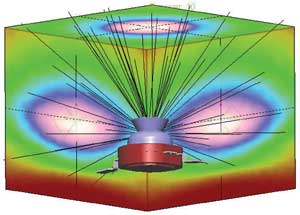
This LightTools simulation is of a Philips
Lumileds’ Luxeon side-emitting LED with a luminance pattern. Courtesy of Synopsys.
“Important recent advances in illumination design software
allow designers to define detailed characteristics of a light source and then optimize
a collector optic or a collection of lenses to produce the desired illumination
pattern at the receiver surface of interest,” said George Bayz, vice president
and general manager of the Optical Solutions Group.
Part of the demand from the illumination market can be attributed
to the continued rise of LED lighting. Many software companies, including Synopsys,
are responding to this trend by conducting ongoing research into new software features
to improve the design of LEDs. For example, Synopsys’ LightTools range provides
LED design features to support accurate emission modeling, phosphor modeling, color
analysis and the ability to optimize complex geometry.
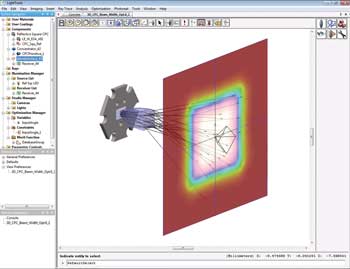
Shown is a LightTools simulation
of LED collimation optics using a compound parabolic concentrator. Courtesy of Synopsys.
Designers can tailor the illumination system to send light only
where it is needed, which, when done properly, can lead to substantial energy savings
and increased aesthetic appeal, Bayz said.
Excitement over aspherics
Creating a stir for lens makers is a technique developed by Dr.
Greg Forbes, which has made its way into software programs. It provides a way of
designing cost-effective aspheres more easily than ever.
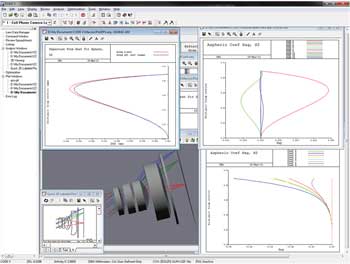
CODE V 10.3 includes new capabilities specifically for aspheric lens
design and optimization. Courtesy of Synopsys.
Forbes, who published his first paper on this topic in an April
2007 issue of Optics Express, developed rotationally symmetric representations of
aspheres that give lens designers more control over the surface of the lens.
Forbes’ work is compelling because it has the potential
to change how aspheres are being described, displacing methods existing for more
than a century, said Richard Youngworth, director of optical engineering at Light
Capture Inc. “[Forbes’] work enables direct knowledge of how producible
a surface will be, right in the design process. The paper noted here is the first
in a series, and other people have picked up on the work. It is very exciting because
aspheres are a key to better performing systems with more stringent constraints,
and making them cost-effectively is key.”
The excitement over aspheric lenses has arisen because they can
provide significant design advantages such as replacing multiple spherical elements
with one aspheric element. The result is a device that is smaller, lighter and potentially
less expensive.
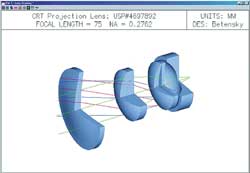
This cutaway is a solid model view of a CRT projection lens (US patent 4,697,892) with on- and off-axis ray bundles traced; produced by OSLO. Courtesy of Lambda Research Corp.
Forbes’ work has been incorporated into a number of packages,
including Synopsys’ CODE V version 10.3, which uses it in its new Asphere
Expert tool to automatically find optimal asphere locations in the lens system.
The tool uses a unique algorithm that takes into account both aspheric slope departure
limits and weighted constraints when computing recommended aspheric surface locations.
“For imaging applications, it is an exciting time in optics
design, fabrication and testing,” Bayz said. “The industry has made
tremendous recent advances in making it viable for the lens design community to
routinely consider adding aspheres to a design form without prohibitive cost consequences.
These advances enable optical designers to more easily take advantage of the unique
image quality and cost benefits that aspheres offer.”
An additional cost benefit for optical designers comes from using
optical software to carry out tolerance analysis. The trend sees optical design
software stepping in at increasingly early stages – even in the design process
– to assess whether a system will perform as expected.
Light Capture’s Youngworth believes that this has always
been the weak link in optical design. He said that the fact that many groups are
starting to address it is an important step forward, which will lead to cost savings
as well as an increase in quality.
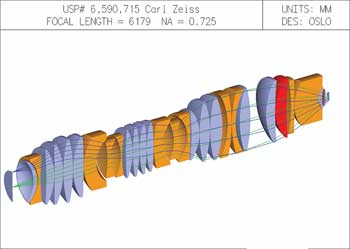
A cutaway solid model view produced using OSLO of a Carl Zeiss lens system (US patent
6,590,715) with on- and off-axis ray bundles traced. Courtesy of Lambda Research Corp.
But increasingly sophisticated software is not all good news for
the optics and photonics industry, said Michael Gauvin, vice president of sales
and marketing at Lambda Research Corp.
He believes that optical design software has been both a benefit
and a detriment to the optics/photonics industry. It has enabled experienced optical
designers to create exceptional designs for imaging and nonimaging systems, he said,
but there is a loss of understanding in the science behind optical design.
“Too often, users push a button to optimize an optical system
that can’t be manufactured, use glass types that are no longer available or
are impossible to tolerance into a manufacturable design,” he said. “This
puts the optical manufacturing companies in a bad situation, where they are left
holding the bag to fix designs that work poorly or are impossible to manufacture.”
In particular, it is the nonoptical engineers who can experience
problems during manufacturing – who, through trial and error, create a lens
design in an optical design software product. The only way to improve upon this
situation, Gauvin advises, is through education, more intuitive software and easier-to-use
interfaces that guess what the user ultimately wants to do, which then creates the
best manufacturable design.